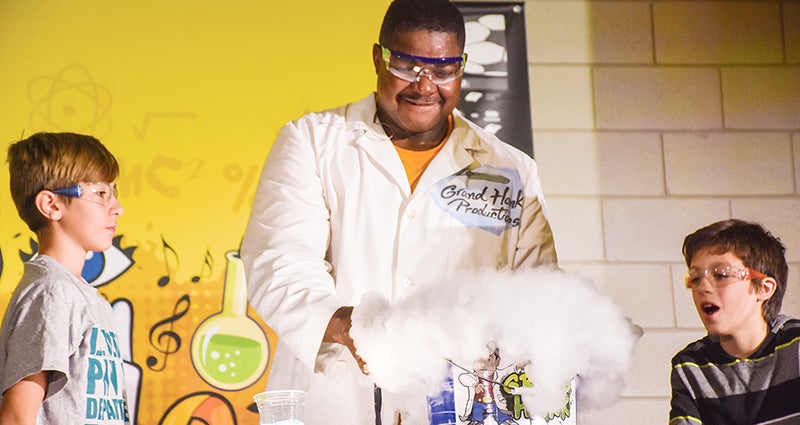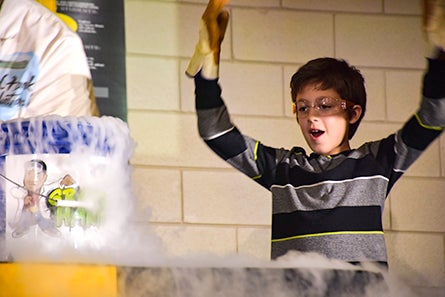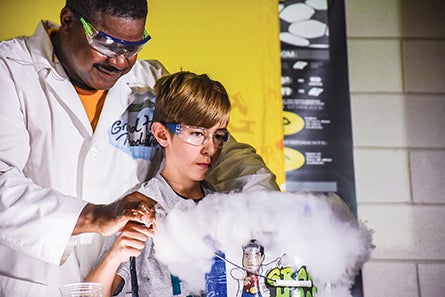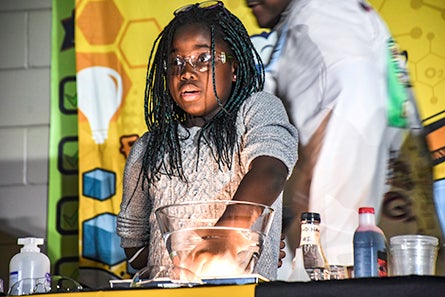‘Anyone can be a scientist’; Chemistry fun sparks imagination for IJ Holton students
Published 9:12 am Wednesday, October 24, 2018

- Left to Right: Alex Coile, a sixth grader at IJ Holton, Tyraine “Grand Hank” Ragsdale, and Samuel Mata, a fifth grader, participate in a chemistry experiment Tuesday afternoon as part of a STEM-geared educational opportunity. Photos by Hannah Yang/hannah.yang@austindailyherald.com
Giant bubbles, voice changing experiments and smoke rings; chemistry came alive for IJ Holton students Tuesday afternoon.
Around 850 students sat inside the gymnasium while Tyraine “Grand Hank” Ragsdale conducted creative science experiments to engage fifth and sixth graders about STEM education and how even a “boring subject” can be cool. Even if a student isn’t necessarily great at science from the start, the point was to show that with hard work, “anyone can be a scientist,” according to Ragsdale.
“When I got to the University of Pittsburgh, I was scared of science,” he shared. “One or two chemistry tests I didn’t do well in. I share those stories with kids because you’re not gonna be great at it from the start, but you can become good at it.”

Samuel Mata, an IJ Holton Intermediate School fifth grader, excitedly reacts to a chemical reaction during a science demonstration held at the school on Tuesday afternoon.
Grand Hanks Productions, Inc. is a multimedia educational, production company that was established to provide educational training and instruction to students, educators and administrators of grades K-12 through live and recorded production technologies, communications and marketing methods.
Ragsdale is internationally known as a STEM educator and worked as a research scientist for the Johnson & Johnson family of companires. The teaching methodology that he developed over the past 23 years, helped Ragsdale reach more than 10 million students, parents and administrators across the country and internationally.
“This was always a dream of mine,” he said. “There’s a vast problem in rural communities and urban communities where there’s not enough access to resources for STEM. It’s a long haul, but I wanted to show kids that you don’t quit and that you give yourselves an opportunity for success.”

Left to Right: Tyraine “Grand Hank” Ragsdale, helps Alex Coile, an IJ Holton Intermediate School sixth grader, conduct a chemistry experiment on Tuesday afternoon.
Administrators praised Ragsdale’s performance by engaging students using different approaches such as live demonstrations as well as music that enriched their educational experiences.
“We were very fortunate to have (Ragsdale) come to IJ Holton,” said Principal Dewey Schara. “It fits in perfectly with our STEM education curriculum, and having our students think about post-secondary education. He did a phenomenal job, and keeping 850 students occupied for an hour and a half is a miracle.”
The overall experience was sponsored by The Hormel Foundation and with the American Petroleum Institute, which helped bring Grand Hank out to IJ Holton for the demonstrations. American Petroleum Institute Consulting Director Dan Gunderson shared that the assembly was also trying to foster an interest for STEM-centric professions so that students can consider entering a career field in the future earlier in their educational careers.

Makayla Dokpodjo, an IJ Holton Intermediate School fifth grader, dips her hand into a bowl of liquid as part of a chemistry demonstration held on Tuesday afternoon.
“We’re really wanting to engage students by the age of 12,” Gunderson stated. “They are more likely to succeed in post-secondary learning.”
Having Ragsdale as a role model in the field for IJ Holton students was intentional. According to Schara, now that the majority of Austin Public School students are of color, having role models in the STEM field like Ragsdale was imperative for minority students to envision themselves as being successful as well.
From studies done by the Pew Research Center, minorities continue to be underrepresented in the STEM workforce, as well as women. Black STEM workers make up about 11 percent of the U.S. workforce overall, but represent 9 percent of STEM workers, while Hispanic workers comprise 16 percent of the U.S. workforce, but only 7 percent of all STEM workers.
“Our students need more role models who look like them,” Schara said. “This opportunity was absolutely perfect in targeting kids and families to consider a career in this field.”
Ragsdale also projected that in the future there will be a shortage of workers in the STEM industry and wanted to foster and create a love for the sciences so that younger students may enter the field through a “pipeline” to respond to shortages that may come.
He is also anticipating the opening of his science center in Philadelphia in early 2019 that would continue to educate the public about the wonders of STEM and how the world continues to benefit and advance through the work that scientists does.
“Science by nature is a catalyst that I use to energize kids,” he said. “It’s beautiful.”





